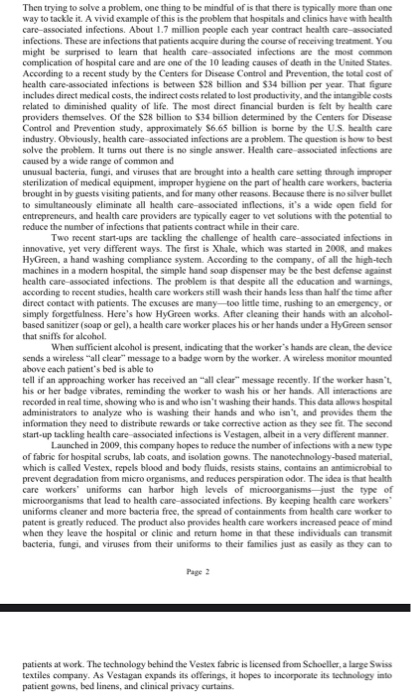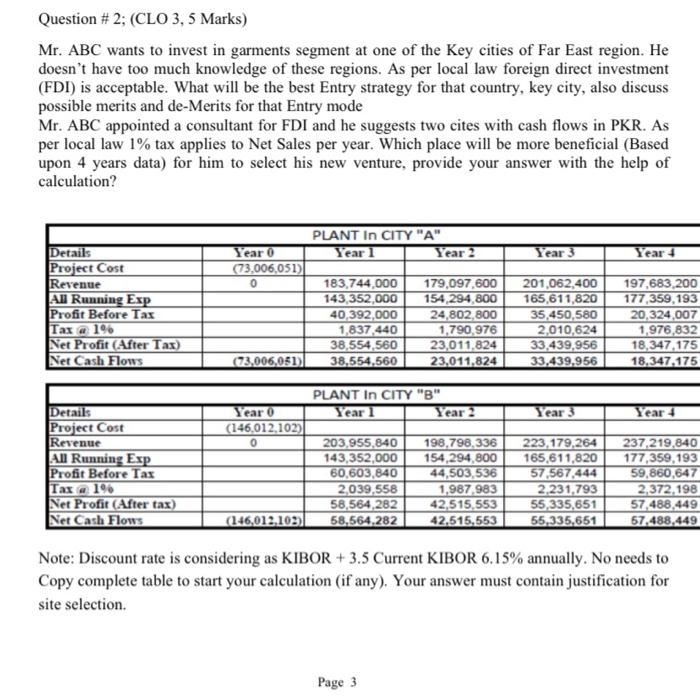case study "entrepreneuship" subject


Then trying to solve a problem, one thing to be mindful of is that there is typically more than one way to tackle it. A vivid example of this is the problem that hospitals and clinics have with health care-associated infections. About 1.7 million people each year contract health care-associated infections. These are infections that patients acquire during the course of receiving treatment. You might be surprised to learn that health care associated infections are the most common complication of hospital care and are one of the 10 leading causes of death in the United States. According to a recent study by the Centers for Disease Control and Prevention, the total cost of health care-associated infections is between $28 billion and $34 billion per year. That figure includes direct medical costs, the indirect costs related to lost productivity, and the intangible costs related to diminished quality of life. The most direct financial burden is felt by health care providers themselves. Of the s28 billion to $34 billion determined by the Centers for Disease Control and Prevention study, approximately $6.65 billion is borne by the U.S. health care industry. Obviously, health care associated infections are a problem. The question is how to best solve the problem. It turns out there is no single answer. Health care associated infections are caused by a wide range of common and unusual bacteria, fungi, and viruses that are brought into a health care setting through improper sterilization of medical equipment, improper hygiene on the part of health care workers, bacteria brought in by guests visiting patients, and for many other reasons. Because there is no silver bullet to simultaneously eliminate all health care-associated inflections, it's a wide open field for entrepreneurs, and health care providers are typically eager to vet solutions with the potential to reduce the number of infections that patients contract while in their care. Two recent start-ups are tackling the challenge of health care-associated infections in innovative, yet very different ways. The first is Xhale, which was started in 2008, and makes HyGreen, a hand washing compliance system. According to the company, of all the high-tech machines in a modern hospital, the simple hand soap dispenser may be the best defense against health care-associated infections. The problem is that despite all the education and warnings, according to recent studies, health care workers still wash their hands less than half the time after direct contact with patients. The excuses are many too little time, rushing to an emergency, or simply forgetfulness. Here's how HyGreen works. After cleaning their hands with an alcohol based sanitizer (soap or gel), a health care worker places his or her hands under a HyGreen sensor that sniffs for alcohol When sufficient alcohol is present, indicating that the worker's hands are clean, the device sends a wireless all clear" message to a badge worn by the worker. A wireless monitor mounted above each patient's bed is able to tell if an approaching worker has received an "all clear" message recently. If the worker hasn't his or her badge vibrates, reminding the worker to wash his or her hands. All interactions are recorded in real time, showing who is and who isn't washing their hands. This data allows hospital administrators to analyze who is washing their hands and who isn't, and provides them the information they need to distribute rewards or take corrective action as they see fit. The second Start-up tackling health care associated infections is Vestagen, albeit in a very different manner. Launched in 2009, this company hopes to reduce the number of infections with a new type of fabric for hospital scrubs, lab coats, and isolation gowns. The nanotechnology-based material which is called Vestex, repels blood and body fluids, resists stains, contains an antimicrobial to prevent degradation from microorganisms, and reduces perspiration odor. The idea is that health care workers' uniforms can harbor high levels of microorganisms just the type of microorganisms that lead to health care-associated infections. By keeping health care workers uniforms cleaner and more bacteria free, the spread of containments from health care worker to patent is greatly reduced. The product also provides health care workers increased peace of mind when they leave the hospital or clinic and return home in that these individuals can transmit bacteria, fungi, and viruses from their uniforms to their families just as easily as they can to Page 2 patients at work. The technology behind the Vestex fabric is licensed from Schoeller, a large Swiss textiles company. As Vestagan expands its offerings, it hopes to incorporate its technology into patient gowns, bed linens, and clinical privacy curtains. Question # 2; (CLO 3, 5 Marks) Mr. ABC wants to invest in garments segment at one of the Key cities of Far East region. He doesn't have too much knowledge of these regions. As per local law foreign direct investment (FDI) is acceptable. What will be the best Entry strategy for that country, key city, also discuss possible merits and de-Merits for that Entry mode Mr. ABC appointed a consultant for FDI and he suggests two cites with cash flows in PKR. As per local law 1% tax applies to Net Sales per year. Which place will be more beneficial (Based upon 4 years data) for him to select his new venture, provide your answer with the help of calculation? PLANT IN CITY "A" Year 1 Year 2 Year 3 Year 4 Year 0 (73.006.051) 0 Details Project Cost Revenue All Running Exp Profit Before Tax Tax a 196 Net Profit (After Tax) Net Cash Flows 183,744,000 143,352,000 40,392,000 1,837 440 38,554,560 38,554,560 179,097,600 154,294,800 24,802,800 1.790,976 23,011,824 23,011,824 201,062,400 165,611,820 35,450,580 2,010,624 33,439,956 33,439.956 197,683,200 177,359,193 20,324,007 1,976,832 18,347,175 18,347,175 (73,006,051) PLANT IN CITY "B" Year 1 Year 2 Year 3 Year 4 Year (146,012,102) 0 Details Project Cost Revenue All Running Exp Profit Before Tax Tax @ 196 Net Profit (After tax) Net Cash Flows 203,955,840 143,352,000 60,603,840 2,039,558 58,564,282 58,564,282 198,798,336 154,294,800 44,503,536 1,987,983 42,515,553 42,515,553 223,179,264 165,611,820 57,567,444 2,231,793 55,335,651 55,335,651 237,219,840 177,359,193 59,860,647 2,372,198 57,488,449 57,488,449 (146,012,103) Note: Discount rate is considering as KIBOR + 3.5 Current KIBOR 6.15% annually. No needs to Copy complete table to start your calculation (if any). Your answer must contain justification for site selection. Page 3








